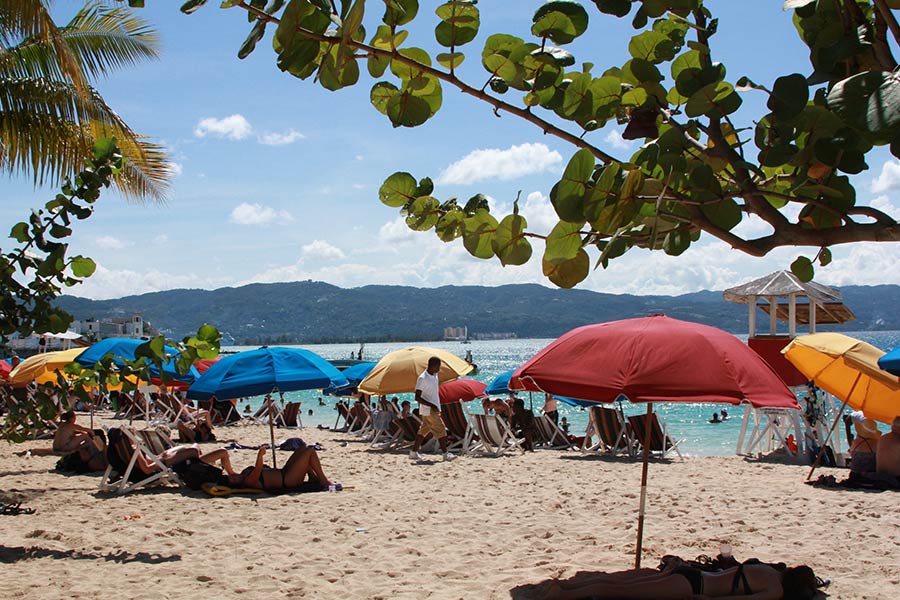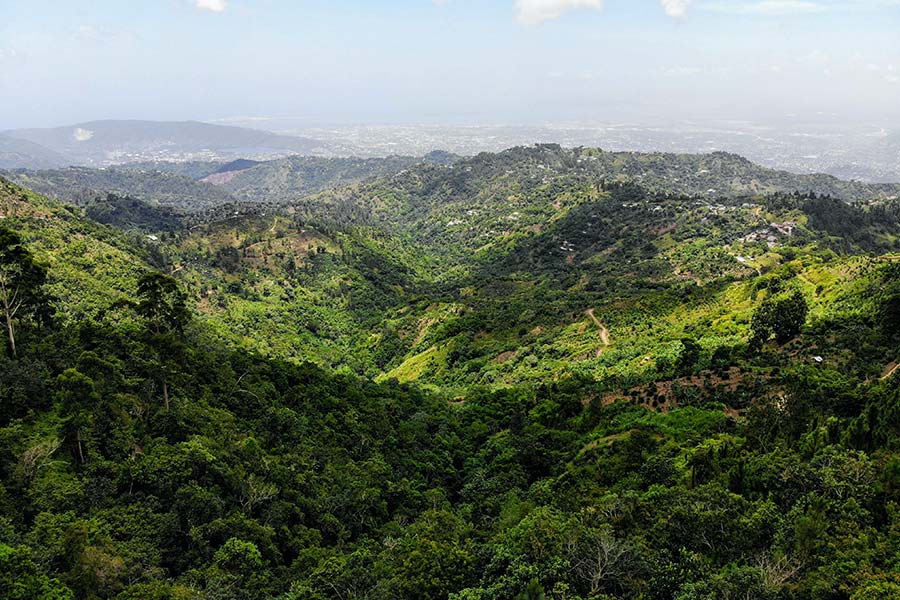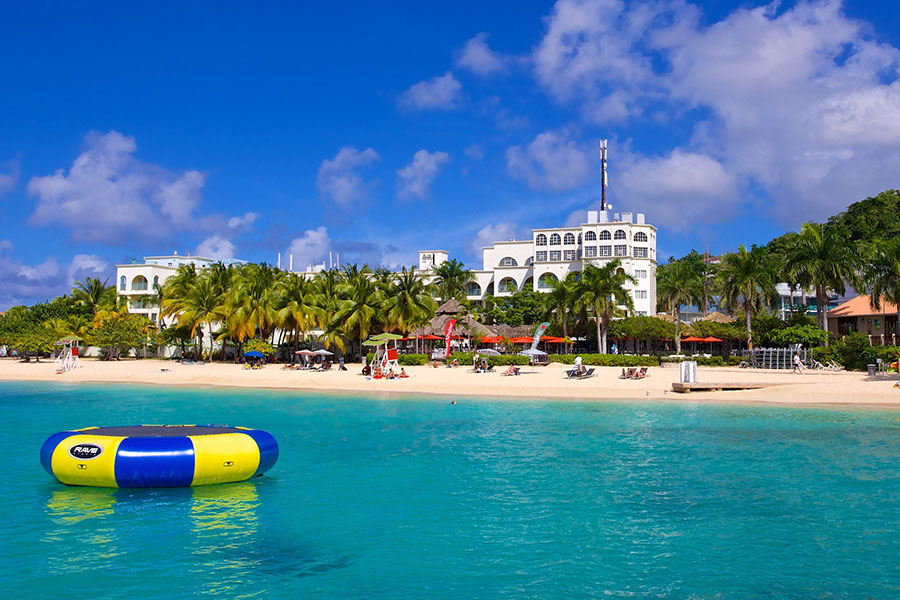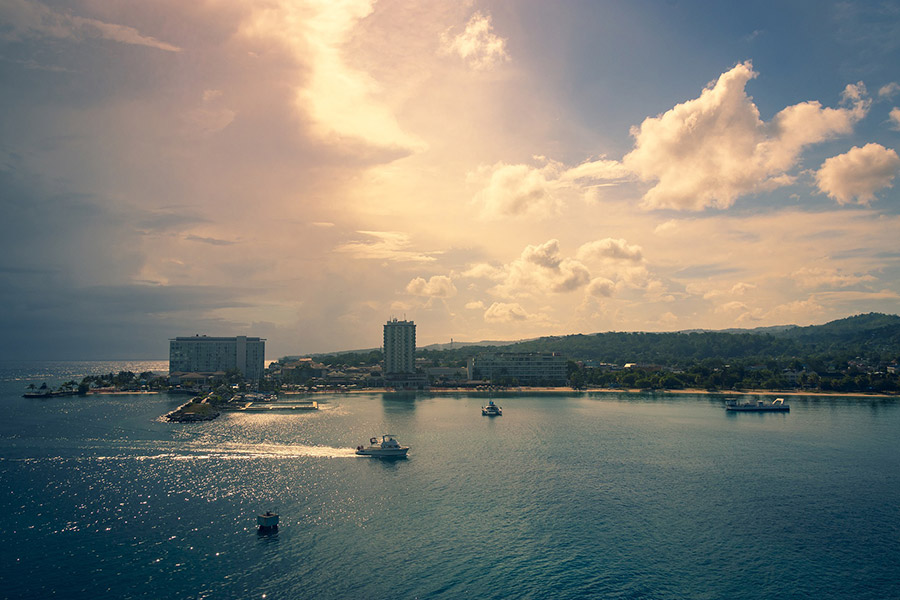Understanding Jamaica's Weather & Climate
When you think of Jamaica and weather, think paradise, because that’s the only way to truly describe it. No one here needs bulky winter coats or mittens to go about their day, even in the height of winter. Year-round, shorts, sleeveless shirts, and sundresses are still the go-to fashions for tourists and locals alike.
The next thing about weather in Jamaica is that it also doesn’t get too hot. The weather dictates lightweight clothing that you can wear any time of the year.
When planning your trip to Jamaica, or anywhere in the world, it’s important to keep the weather and climate in mind. Here’s what you need to know:
Understanding Jamaica's Weather & Climate
Jamaica is located north of the equator at about 18°N and °77W, south of the island of Cuba, and is surrounded by the Caribbean Sea. 
Trade Winds
The island’s climate is highly influenced by the North-East Trade Winds. These are the same winds that help ships sail around the world. They are also the driving force for hurricanes and storms, which are pretty common in Caribbean Islands like Jamaica.
During the winter months, these winds, called ‘Northers’, blow onshore from North America, causing temperature drops from December to March.
Sea
Jamaica has a tropical marine climate. This means the island’s climate is strongly influenced by the sea.
Trade winds pick up moisture from the warm seas surrounding the island which rises as they approach mountainous barriers and falls as relief rainfall. Sea temperatures in Jamaica range are always warm, even in the winter months, and don’t typically fall below 78.8°F (26°C).
Topography and Vegetation
Despite these factors, some Caribbean islands experience higher temperatures throughout the year than Jamaica. The reason for this is topography, along with vegetation, which also has a huge influence on the climate. 
Jamaica is a mountainous country, of which ⅓ is covered in lush vegetation. For every 100 meters or 300ft, temperatures fall by about 1°F. Variations in elevation result in cooler temperatures, particularly in places like the Blue Mountain region which spans the eastern parishes of the island, and the Mandeville region on the island’s south coast.
Understanding Weather Patterns in the Caribbean
Jamaica’s tropical marine climate means conditions are well balanced throughout the year. There are no temperature extremes as there are with other types of climates, and there are no prolonged periods of wetness or dryness.
Does it Stay Warm All Year in Jamaica?
Pretty much. Jamaica does not experience snowy winters like other places in the world, and the temperature doesn’t drop by much. Jamaica weather can get a little chilly now and then, but the most you’ll need is a light sweater to keep the gentle winds off.
When is the Rainy Season in Jamaica?
Though the Caribbean's hurricane season happens from June 1st to November 30th each year, the rainiest months in Jamaica are October and May every year. 
Jamaica experiences an average of about 70 inches (1800 mm) of rainfall per year. In the South Coast, convectional rainfall is most common. Rainfall is heaviest on the island’s North Coast due to relief rainfall. So, in the mountainous regions, this average will increase to about 134 inches (3,400 mm) per year.
The infamous Blue Mountains can see average rainfall exceeding 200 inches (5000 mm) with its rainshadow effect leaving the nation’s capital city, Kingston, on the windward side with significantly less, about 28 inches (710 mm).
What is the Best Time to Visit Jamaica for Good Weather?
Ironically, the best time to visit Jamaica is during the drier months from December to April.
The reason for this is that this lies directly outside of the hurricane season. The hurricane season in Jamaica can ruin your trip, as the destruction from hurricanes can be unpredictable, and you’d hate to be stuck with no power and access to the amenities you’ve come to rely on.
But this is no hard and fast rule. There is ample warning before any storms or hurricanes hit the island, so this is nothing to worry about unless you’re planning a trip that will last more than a few weeks.
Plus, unlike other tropical destinations, Jamaica does not experience entire days of rain. If it falls in the morning, your afternoon is likely free. Most times, however, rainfall occurs in the afternoon and into the night, so plan your activities around the weather forecast. 
Year-Round Average Temperatures in Popular Jamaica Destinations
If you’re planning to visit Jamaica soon, you’ll likely be headed to the most popular tourist spots on the island, namely Montego Bay, Negril, Ocho Rios, and Kingston. Here’s some info about the average yearly temperatures in these areas to help you better prepare:
Montego Bay
Though the temperature variations in Jamaica weather are small, Montego Bay, or Mobay, stands out as having some of the highest temperatures on the island.
The hottest month is July, with temperatures reaching up to 91°F (32°C) and the coolest in January, about 82 °F (27°C)
Negril
Though not as built-up as Montego Bay, this quaint seaside town is one of the most popular spots on the island for tourists looking to enjoy the sea, sand, and sun.
The hottest month in Negril is also July, reaching temperatures of 86 °F (30°C). The coolest month in Negril is also January at 82 °F (27°C)
Ocho Rios
Of all the major tourist destinations in Jamaica, Ocho Rios has the most pleasant weather conditions, remaining fairly uniform throughout the year.
From June to October, the temperature remains fairly constant at about 88 °F (31°C), falling to as low as 73°F (22°C) in January and February. 
Kingston
Kingston is the tourist hotspot on this list that is located on the island’s south coast. It is the capital city of Jamaica and holds great historical significance. Kingston is also the island’s admin and commerce hub and the go-to place for most modern services.
Like Montego Bay, temperatures may rise to 91 °F (32°C) during the months of July and August, with the coolest months from December to March averaging 73 °F (22 °C).
When is the Coldest Time of Year in Jamaica and How Cold Does It Get?
The coldest month in Jamaica is January. It doesn’t get very cold though and the average temperature is 75°F (24°C ).
For some visitors who are used to harsh cold temperatures, Jamaica weather is just fine.
When is the Warmest Time of Year in Jamaica and How Warm Does It Get?
The hottest month in Jamaica is July. Temperatures climb to 82°F (28°C).
Notice there isn’t much variation between the coldest and the hottest month, and depending on where on the island you are, there’ll more often than not be a strong enough breeze to keep you cool. 
Jamaica's Weather in January
January is the coolest month of the year in Jamaica. Note that being cool means it is not cold, so leave your winter coats at home. There is usually about 8 hours of sunshine, with nighttime coming sooner than usual.
Jamaica's Weather in February
February is also a relatively cool month. It has less than 12 hours of sunshine as it is a winter month, and is also one of the driest months of the year.
Jamaica's Weather in March
March is one of the driest months. It will still rain but showers occur, though short-lived. 
During this time the weather begins to warm up, and the amount of hours of sunshine increases to about 12 hours.
Jamaica's Weather in April
April marks the end of the dry season in Jamaica. The island begins to experience more moderate rainfall, and temperatures rise gradually during the Spring months.
Jamaica's Weather in May
May is one of the wettest months of the year, so pack an umbrella if you’ll be out all day. Despite this, temperatures are still relatively high and conditions are muggy.
Jamaica Weather in June
June is where things really begin to heat up. Summer begins and this month is home to the longest day of the year. But, there’s shade everywhere and you’ll likely be fine with a light breeze.
There are more sunshine hours, school is out, and you’ll find more locals at the beach and outdoor public spaces enjoying the pleasant Jamaica weather.
Jamaica's Weather in July
July is the hottest month of the year in Jamaica. There are over 10 hours of bright sunshine. Sunscreen is a must, and air conditioning and electric fans are a great addition to any accommodation.
The heat also means the hurricane season is active and conditions are ripe for storms. 
Jamaica's Weather in August
August is another hot month, but the island is cooled down by the rise in precipitation. Here, humidity increases, and it’s a great time to get those air conditioning units going for maximum comfort.
Jamaica's Weather in September
As the summer ends, September will experience remnants of the hot sun, so you’ll still need to use lots of sunscreen. Rainfall averages continue to increase and afternoon rains are more common.
Jamaica's Weather in October
October is the next peak of the wet season and the island’s most humid month. The seas are warm, and the hours of sunshine begin to decrease again, just in time for the island’s winter season.
Jamaica's Weather in November
As it approaches winter, the temperatures begin to fall. November is also a wet month, particularly for the North Coast, but not so wet that it will ruin your trip.
The sun goes down before 6 pm and the nights are cool and comfortable.
Jamaica's Weather in December
December is the start of the dry season. The days are slightly humid, but the nights are comfortable and cool.
It’s Christmas time, and the atmosphere is always festive. The seas are warm, and a stark difference from the rest of the Northern hemisphere. It’s one of the most popular months for tourists to visit.
All of our content at Caribbean Tourbase is written by experienced travel writers who have visited all of the locations we recommend. And our review board of local tourism experts ensure that all the information we provide is accurate, current and helpful